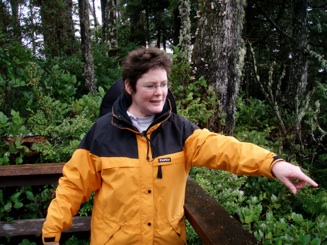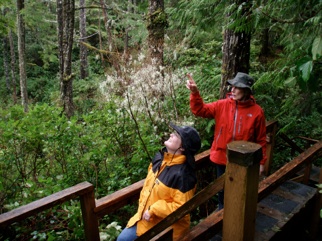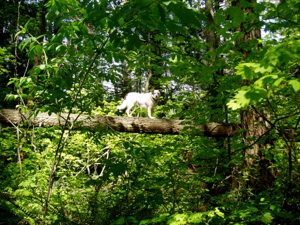consensual coordination of consensual coordination


To the extent that language is a manner of living in coordinations of coordinations of consensual behaviors, nearness of co-existence in doing many things together is necessary for language to arise. At the same time, for nearness of co-existence to occur as a relational background in which languaging could arise spontaneously in the recursion of doing things together, it must be permanent, or recurrent and sufficiently prolonged. What can we say now about what may have been the biological fundaments for such nearness in the origin of our lineage as languaging primates?
Judging by the brain capacity of the skull of Australopithecus afarensis (about 450 cc), the brain of our ancestors 3 million years ago must have been larger than the brain of a domestic dog. Indeed, it must have been about the size of the brain of a chimpanzee. Dogs do not live in language among themselves or with us, but when we live with them in some stable nearness in intimacy and in the proper flow of recurrent interactions, we can live languaging circumstances with them, in which they participate in a more or less extended episodic manner. So the brain size of a dog allows it to enter with us in consensual coordinations of consensual coordinations of behaviors.
But for that to happen to a dog living with us, or for that to happen between any pair of animals, certain emotioning (or configuration of relational dynamics) is necessary. That is, the emotioning must be such that the frequent recurrent interactions that take place between those animals should conform a domain of coordinations of behavior in which recursive consensual coordinations of coordinations of behavior may arise. Furthermore, a special emotioning must also take place in the living together in coordinations of consensual behaviors so that the occasional episodes of languaging lived may become a manner of living that is conserved as a matter of course in the spontaneous learning of the offspring, with the result that a lineage defined by a coexistence in language begins. According to us, since love is the only emotional dynamics that gives rise to a living together in the close and sensual nearness in which a prolonged living together in recursive consensual coordinations of doings can take place for the pleasure of it, that emotioning must be love.
Origin of Humanness in the Biology of Love, page. 61
repetition to recursion
As any particular sequence of behaviours between two animals that live together, that is have the opportunity for a repetition to happen many, many, times, likely several hundred times, that repetition takes on a regularity, and hence a “presence” of its own.
In early animal behaviour studies people developed the notion of an “intention movement” as a coordinating device, ie. the first bit of a sequence elicited the response that was appropriate for the sequence. I think this is not dissimilar to what happens as the first step in a coordination of coordinations. For example pointing... it coordinates our attention as if we were about to be moving in that direction. If you watch a baby who is learning to “look at the bird” they are not responding to the notion of “a bird” but rather looking in the way you are looking, and the movement of the bird may catch their further attention. Dogs look right where the finger is, as if it were a nose pointing to something suitable. I taught Sindi to look along the line of sight by gradual increments of distance from caches of treats.
In all these cases, and many more that you may notice as you begin to look, a meaningful gesture has arisen from the beginning of an action. Now we use the gesture itself as a coordination of coordination. A recursion has been generated. Put differently: an element of a sequence becomes a token, or sign, of the sequence, as distinguished by an observer. It is always an observer already operating in language who sees this as a “token” or a “signal” -- for the beings involved, it just “works”.




the first recursion is language
Consensual coordination is a normal, common way of two or more beings coordinating their living in the same space in realtime structural coupling. Their behaviour is coordinated without any need to think or evaluate - it is simply part of how beings behave together in workable a matrix of relations.
I had not studied Maturana’s work 35 years ago when I had a baby and was watching the development of his language, and that of all the other young ones around. Hence, a lot of what I have learned I learned from my dog through trying to discern to what extent she is capable of language. I am not interested in competing for a maximum vocabulary, I’m not interested in how well I can “train” this being; I want to “converse” with her as much as she is capable of. After all, her nervous system is adequate, and she is a social being, like most canids.
Early on I learned that Sindi responds to my sounds not according to what I think I say, but according to the action that the sound coordinates, from her perspective. For example, “rrrrope”which I thought meant “rope” turned out to mean “lets play pulling on something”. “Soon” means “wait” for her, and “soon, soon, soon” means “wait a while, be patient”, and “soon, soon, soon.... etc.... soon” means I am going out of town and she heads off to her bed and looks dejected. I see now how “pidgin english” would naturally arise.
I also wanted to be sure she could initiate a conversation, that she had a “say” in things. So she has invented, as most dogs do, a vocabulary of gestures and sounds for what she wants. For example, she tried to copy my sound of saying “mmmm” when I was eating something good - it sounds like a quiet growl - and for her this means “please.” I respond either with what she wants, or tell her no. She understands fully when I say “no, not now” or shake my head, or my hand as a proxy of my head. Having been always consistent in this, she then stops pestering me as some dogs might.
(By the way, I think shaking a head for “no” is a natural step from turning away to withhold food in your jaw, while dipping it down is an offer of “have some.”)
You will have noticed by now that many of the photos I have of Sindi on this website have her “posed” in some odd location. This is all part of our coordination, she lies down when I take out my camera, or, if I point at something and tell her to go there and sit... she does...including finding a route to get there if I suggest “go around.” Not for the photo, for the treat that follows!
Sindi has not been capable of engaging in the next recursion, the consensual coordination of consensual coordination of consensual coordination; ie. distinguishing and naming, discussed on the next page.
blue sky

